Eff = 100. / (1. + exp( -(x - HV95)/B + C))
where C = ln(0.05/0.95), and the fitted parameters are the slope B and HV95 - high voltage, corresponding to an eff=95% ("knee point"). The values of the parameter HV95 are compared at different conditions (see below). Note that the actual HV settings were slightly different from the nominal ones used here. Their departures from the nominal HV were (in kV) -0.02, 0.02, 0.0, -0.01, 0.0, and 0.02, corresponding to layers 1-6. In the beginning of data taking, the actual HV settings were adjusted to have approximately the same amplitude of signal from the cathode front end. The parameter HV95 allows us to do this as well, but using information from the anode front end (on the condition of having one and the same anode front end thresholds).
(HV = 3.1-3.9 kV, Qth=20 fC, Runs 440-478) :
Fig.4 - efficiency and Fig.4a -inefficiency, all layers
Fig.4b_1 - layer 1, Fig.4b_2 - layer 2, Fig.4b_3 - layer 3
Fig.4b_4 - layer 4, Fig.4b_5 - layer 5, Fig.4b_6 - layer 6
HV95 (kV, layers 1 - 6) = 3.31 3.25 3.23 3.29 3.30 3.31.
(HV = 3.2-3.8 kV, Qth=20 fC, Runs 669-675) :
Fig.5a - efficiency and Fig.5b -inefficiency, all layers
HV95 (kV, layers 1 - 6) = 3.26 3.37 3.35 3.30 3.27 3.32.
CLCT(3/6)*scint., (HV = 3.3-3.8 kV, Qth=30 fC, Runs 717-722) :
Fig.6a - efficiency and Fig.6b -inefficiency, all layers
HV95 (kV, layers 1 - 6) = 3.36 3.40 3.42 3.40 3.34 3.39.
CLCT(3/6)*scint., (HV = 3.3-3.8 kV, Qth=30 fC, Runs 705-710) :
Fig.7a - efficiency and Fig.7b -inefficiency, all layers
HV95 (kV, layers 1 - 6) = 3.40 3.46 3.47 3.46 3.34 3.45.
| Conditions | L1 | L2 | L3 | L4 | L5 | L6 |
|---|---|---|---|---|---|---|
|
96 ch board Qth=20 fC |
3.31 | 3.25 | 3.23 | 3.29 | 3.30 | 3.31 |
|
16 ch board Qth=20 fC |
3.26 | 3.37 | 3.35 | 3.30 | 3.27 | 3.32 |
|
16 ch board Qth=30 fC |
3.36 | 3.40 | 3.42 | 3.40 | 3.34 | 3.39 |
|
16 ch board Qth=30 fC |
3.40 | 3.46 | 3.47 | 3.46 | 3.34 | 3.45 |

